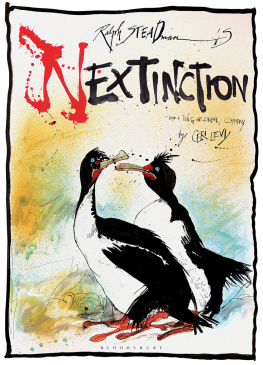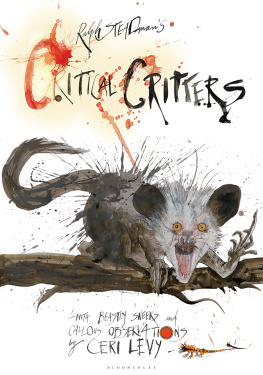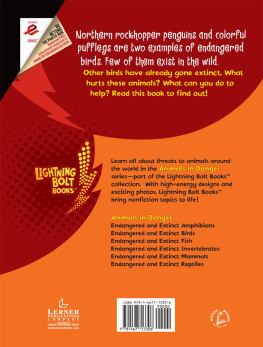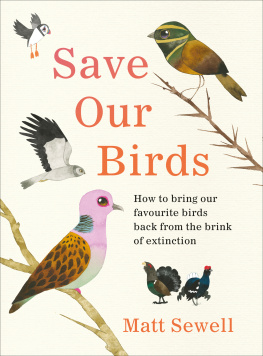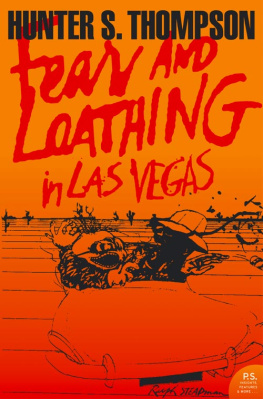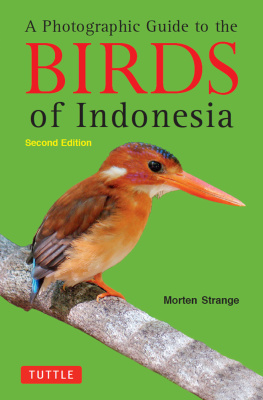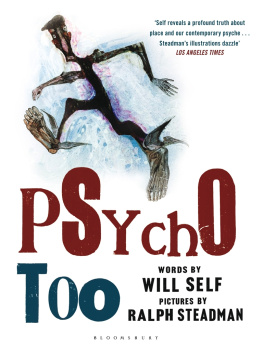

Bloomsbury Natural History
An imprint of Bloomsbury Publishing Plc
| 50 Bedford Square | 1385 Broadway |
| London | New York |
| WC1B 3DP | NY 10018 |
| UK | USA |
www.bloomsbury.com
Bloomsbury is a trademark of Bloomsbury Publishing Plc
This electronic edition published in 2015 by Bloomsbury Publishing Plc
First published 2015
Copyright illustrations by Ralph Steadman, 2015
Copyright text by Ceri Levy, 2015
Ralph Steadman and Ceri Levy have asserted their right under the Copyright, Designs and Patents Act, 1988, to be identified as Authors of this work.
All rights reserved
You may not copy, distribute, transmit, reproduce or otherwise make available this publication (or any part of it) in any form, or by any means (including without limitation electronic, digital, optical, mechanical, photocopying, printing, recording or otherwise), without the prior written permission of the publisher. Any person who does any unauthorised act in relation to this publication may be liable to criminal prosecution and civil claims for damages.
No responsibility for loss caused to any individual or organization acting on or refraining from action as a result of the material in this publication can be accepted by Bloomsbury or the author.
British Library Cataloguing-in-Publication Data
A catalogue record for this book is available from the British Library.
Library of Congress Cataloguing-in-Publication data has been applied for.
ISBN: HB: 978-1-4729-1168-1
ePDF: 978-1-4729-2505-3
ePub: 978-1-4729-1169-8
To find out more about our authors and books visit www.bloomsbury.com. Here you will find extracts, author interviews, details of forthcoming events and the option to sign up for our newsletters.
Theory of Nextinction
Ceri: We should write about the birds that are next in line for extinction.
Ralph: The next in line for extinction are waiting for nextinction.
Ceri: Nextinction! By George, I think hes got it. Perfect, Ralph, absolutely perfect.
Ralph: Its obvious, really.


Nextinction Awaits
What led to this conversation was the moment Jim Martin, our editor at Bloomsbury, called me and said, I think its high time that you and Ralph did another book, so have a think about what that book could be. Get your thinking caps on and get back to me. Cheerio!
Ralph and I thought long and hard about a follow-up book to Extinct Boids and we trawled through potential ideas until it suddenly flashed up that we needed to create a positive book about present-day problems, a book that could show that all is not futile. We want to gently massage the message down throats that we can save creatures. So many species today have become endangered too easily and too readily. And the creatures and monsters that thrive through this era of extinction are the banks, supermarkets, shopping malls, corporate entities and organisations who really should put far more back into the world in return for their role in the decimation of so much nature, which threatens not only our wildlife but also mankind itself. We need change.
If our last book was about all the birds we have lost, then this book has a positive spin as in principle it is about all the birds we can save. These nextinct birds are teetering on the brink and we need to find them and share their stories with you. There is a chance they can be removed from the darkness and returned to the light. In so many ways these birds are the forgotten birds for most people, even though they are living creatures. Everyone knows at least one extinct bird, usually the Dodo, but how many people can actually name a Critically Endangered species, let alone understand what one is? And why are we so much more connected with our past than our present? Why do more people know of an extinct species rather that the plight of the Black Stilt? This collection of birds that Ralph and I are exploring can rectify this. The majority of these critters could be saved with the right medication and there are doctors at the ready waiting to apply the correct cures. It just needs funding through time, money and education.
Scientists estimate the rate of extinction of all species on Earth to be between 1,000 and 10,000 times higher than the natural rate of extinction. As for the birds, since the year 1500, 140 species have become extinct. In this the 21st century there are 1,373 species (one in eight of the worlds birds) that are threatened with extinction and 213 species that are specified as Critically Endangered by BirdLife International for the IUCN Red List (International Union for Conservation of Nature), which generally projects that these species will in all likelihood become extinct within the next 1020 years. This means that too many species are crucially walking the tightrope towards imminent extinction. These birds are somewhere terrible.
What causes the majority of problems? The simple answer is man. Simple enough? But oh how complex everything becomes after that first thought. Many of these birds dont only face one issue but several. Agriculture is the highest ranked threat, with 123 species affected by it. In second place are invasive species, which threaten 108 species; third is climate change, affecting 86 species; fourth is logging at 74 species; then fifth is hunting and trapping, which decimates 64 species. There are lower ranked causes such as human disturbance, energy production and pollution but these first five are the main causes of nextinction.

This is very much a present-tense book. What we describe happening to the birds is happening at this moment in time. What you see and read is our immediate response to this situation. Throughout this period of working with Ralph I have been continuing my journeys through the bird world as I endeavour to complete my filmic exploits of The Bird Effect, a documentary I have been making examining how much birds affect people. Conversely, the more I learn, the more I find how much, on the whole, we adversely affect them. I am not the same person I was before this adventure began and for that I am grateful. I have met some wonderful people, have been to extraordinary places and seen bountiful birds. I have also become engrossed with the subject of exactly what it is that threatens our birdlife.
I have been to Malta and seen the unnecessary slaughter of migratory birds by hunters hunters who have a voracious appetite for the taking of birds lives and who seemingly desire ownership of their very souls. This is a continual process throughout the world and Malta is just one representative of a large clan of shooters, but what I saw on that island is indicative of a fraternity that numbers millions of people aiming their guns skywards in the name of sport.
I have worked with many people at BirdLife International and the RSPB (Royal Society for the Protection of Birds) and seen first-hand conservation in action. This book points out a lot of the work done by BirdLifes Preventing Extinctions Programme, which endeavours to raise money and awareness to save Critically Endangered birds and has our continued support.
Next page
